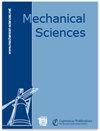Assessment of force control for surface finishing – an experimental comparison between Universal Robots UR10e and FerRobotics active contact flange
IF 1.5
4区 工程技术
Q4 ENGINEERING, MECHANICAL
引用次数: 0
Abstract
Abstract. Robotic surface treatment is already broadly used in the manufacturing industry because it guarantees repeatable high-quality surfaces at short production time. Such a robotic solution, with an accurate control of the applied force on a surface, requires a robot that is either equipped with a force/torque sensor or, alternatively, with a force compliance device. However, without a direct performance comparison, it is hard to know which is the best option for a specific surface treatment operation. Compared to the evaluation of the robot positioning accuracy, using the ISO 9283 test, no standardized test for the quality assessment of robot force control exists yet. In trying to fill this gap, this paper introduces different test scenarios and a test set-up for such a force control quality assessment. As a start, the force control of a Universal Robots UR10e model and a FerRobotics ACF-K 109/04 model are experimentally evaluated. The latter is an external device with controlled force/compliance characteristics, which is referred to as an active contact flange (ACF). For the performance comparison, an ATI force/torque sensor, which is mounted below a work piece, measures the applied force either by the UR or by the ACF. The measured forces are further transformed to the UR tool centre point (TCP) frame. Then, only the z component of the force, or rather the normal force, is relevant for surface treatment and hence important for the evaluation. For each test case, the average value of five test runs with the same parameters is used for the assessment. Results for both the UR and ACF force control are presented for varying desired contact velocities and desired forces. These results indicate the advantage of the ACF-K 109/04 over the UR10e force control for highly dynamic force control scenarios.表面精加工力控制的评估——通用机器人UR10e和FerRobotics主动接触法兰的实验比较
摘要机器人表面处理已经广泛应用于制造业,因为它保证了在短时间内可重复的高质量表面。这样的机器人解决方案,可以精确控制施加在表面上的力,需要一个机器人配备一个力/扭矩传感器,或者一个力顺应装置。然而,如果没有直接的性能比较,很难知道哪种是特定表面处理操作的最佳选择。与使用ISO 9283测试评价机器人定位精度相比,目前还没有针对机器人力控制质量评价的标准化测试。为了填补这一空白,本文介绍了不同的测试场景和这样的力控制质量评估的测试设置。首先,对Universal Robots UR10e模型和FerRobotics acf - k109 /04模型的力控制进行了实验评估。后者是一种具有受控力/顺应特性的外部装置,称为主动接触法兰(ACF)。为了进行性能比较,安装在工件下方的ATI力/扭矩传感器可以测量UR或ACF施加的力。测量的力进一步转换到UR刀具中心点(TCP)框架。然后,只有力的z分量,或者更确切地说是法向力,与表面处理有关,因此对评估很重要。对于每个测试用例,使用具有相同参数的五个测试运行的平均值来进行评估。对于不同的期望接触速度和期望力,给出了UR和ACF力控制的结果。这些结果表明acf - k109 /04在高动态力控制场景下优于UR10e力控制。
本文章由计算机程序翻译,如有差异,请以英文原文为准。
求助全文
约1分钟内获得全文
求助全文
来源期刊

Mechanical Sciences
ENGINEERING, MECHANICAL-
CiteScore
2.20
自引率
7.10%
发文量
74
审稿时长
29 weeks
期刊介绍:
The journal Mechanical Sciences (MS) is an international forum for the dissemination of original contributions in the field of theoretical and applied mechanics. Its main ambition is to provide a platform for young researchers to build up a portfolio of high-quality peer-reviewed journal articles. To this end we employ an open-access publication model with moderate page charges, aiming for fast publication and great citation opportunities. A large board of reputable editors makes this possible. The journal will also publish special issues dealing with the current state of the art and future research directions in mechanical sciences. While in-depth research articles are preferred, review articles and short communications will also be considered. We intend and believe to provide a means of publication which complements established journals in the field.
 求助内容:
求助内容: 应助结果提醒方式:
应助结果提醒方式:


